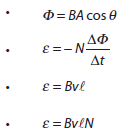|
Nature of science: Experimentation: In 1831 Michael Faraday, using primitive equipment, observed a minute pulse of current in one coil of wire only when the current in a second coil of wire was switched on or off but nothing while a constant current was established. Faraday’s observation of these small transient currents led him to perform experiments that led to his law of electromagnetic induction. (1.8) |
|
Understandings:
Applications and skills:
|
Theory of knowledge:
Utilization:
Aims:
|
Guidance:
Data booklet reference:
|
|


